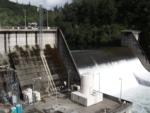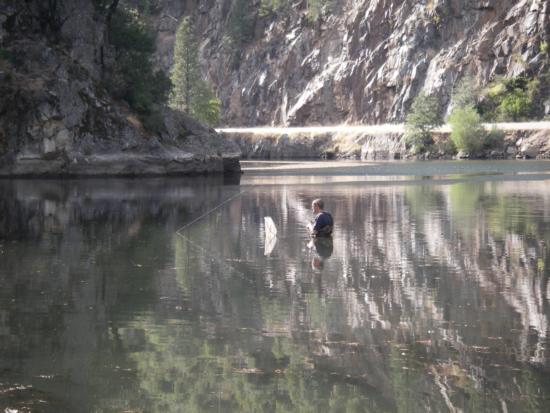Temperature Preference and Tolerance of Hardhead Minnows
-
IssueCalifornia’s populations of hardhead minnow (Mylopharodon conocephalus), a fish species of special concern, have experienced population declines, possibly due to habitat perturbations, including dam construction with consequent temperature changes and the introduction of non-native species to California’s mid- to low-elevation streams. Environmental temperature effects on this large (up to 60 cm (2 ft) Standard Length) native species are poorly documented.

-
Objectives
Knowledge of the temperature tolerance and preference of hardhead, associated with swimming performance across a range of water velocities, is of critical value for management and conservation. Our previous research has examined temperature preference of hardhead, but these studies were limited by the use of only adult fish, the range of acclimation temperatures, and the maximum temperature available to fish during preference testing. The goal of this study was to expand on our previous research by conducting a comprehensive study of wild hardhead temperature tolerances and preferences, using both adult and juvenile fish (fry if available). We examined several key physiological and behavioral variables of hardhead: temperature preference, active swimming metabolism, resting metabolism, critical thermal limits, and blood-oxygen equilibria.
-
Research Activities
To elucidate possible thermal preferences and tolerance in this species we designed a complementary behavioral and physiological study including: temperature preferences, resting and active metabolic rates, and thermal maxima and minima, all with fish acclimated to one of four environmental temperatures (11, 16, 21, or 25°C; 51.8, 60.8, 69.8, or 77°F). We also studied the blood-oxygen equilibria (including whole-blood oxygen affinity) of hardhead across a temperature range of 11-30°C.
-
Results
We found that hardhead can be kept in captivity for long periods of time between 11 and 25°C on commercially available diets, after a transition period including live food supplementation. Hardhead performed very well at moderate (ca. 16-21°C; 60.8-69.8°F) temperatures in our experiments. Regardless of thermal acclimation history, hardhead preferred a mean water temperature of 19.4°C (66.9°F) and clearly avoided temperatures above ca. 26°C (78.8°F). Resting metabolic rates increased with increasing acclimation temperatures in both juveniles and adults, with low to moderate thermal sensitivity. Active metabolic rates ranged from 209-1,342 mg O2 kg-1 h-1 for adult hardhead that swam in Brett-style respirometers at velocities from 30 to 90 cm s-1, providing an estimate of the species’ maximal continuous rate of oxygen consumption (i.e., aerobic capacity). Hardhead lost equilibrium (could no longer maintain themselves in an upright position) when rapidly exposed to water above 29.7°C (85.5°F) or below 7.4°C (45.3°F), not including acclimation acquired zones. These temperature thresholds are ecologically relevant because, in the wild, loss of equilibrium would expose a fish to potential death from predation. Finally, the blood-oxygen study indicated that hardhead had moderately sigmoidal blood-oxygen equilibria curves, high whole-blood oxygen affinities, high hematocrit, total hemoglobin concentration, and blood oxygen capacity, with relatively low nucleotide triphosphate values. These results suggest that this species is suited for some sustained aerobic activity over a range of dissolved oxygen concentrations and instream flow regimes, especially at temperatures <25°C (77°F). However, blood-oxygen affinities were lower at temperatures ≥25°C, indicating a somewhat decreased ability to bind oxygen at the gills at elevated stream temperatures, especially when combined with low dissolved oxygen levels (moderate environmental hypoxia).
-
Outcomes and Impacts
We recommend that water managers simulate natural hydrographs as closely as possible. Hardhead have evolved to cope with seasonal shifts in water temperatures and flows. Altered flow conditions could force hardhead into smaller habitat areas (river sections), especially when river temperatures increase excessively. It is clear from our thermal preference experiments that hardhead avoid 12-14°C (53.6-57.2°F) and 26-28°C (78.8-82.4°F) water. The blood data suggest that hardhead are especially suited to water temperatures below 25°C (77°F), with temperatures above 25°C requiring higher dissolved oxygen concentrations (i.e., a higher partial pressure of oxygen for adequate oxygen binding to their hemoglobin).
Preliminary results have been presented to the California Energy Commission and to stakeholders at a conference of the American Fisheries Society. Several publications are available at the links in Supporting Information section below.
-
Photos
 Dennis Cocherell angling for hardhead in Rock Creek Reservoir, Feather River, Oct. 8, 2010. Photo by Lisa Thompson.
Dennis Cocherell angling for hardhead in Rock Creek Reservoir, Feather River, Oct. 8, 2010. Photo by Lisa Thompson. Juvenile hardhead captured from Rock Creek Reservoir, Feather River, Apr. 19, 2010. Photo by Lisa Thompson.
Juvenile hardhead captured from Rock Creek Reservoir, Feather River, Apr. 19, 2010. Photo by Lisa Thompson. View of a fish being tested in the large temperature preference device, taken from four overhead digital video cameras. Image by Dennis Cocherell.
View of a fish being tested in the large temperature preference device, taken from four overhead digital video cameras. Image by Dennis Cocherell. -
Supporting Information
Kaufman, Robert C., Robert Coalter, Nancy L. Nordman, Dennis Cocherell, Joseph J. Cech, Jr., Lisa C. Thompson, Nann A. Fangue. 2013. Effects of temperature on hardhead minnow (Mylopharodon conocephalus) blood oxygen equilibria. Environmental Biology of Fishes. Published online 08 March 2013, DOI 10.1007/s10641-013-0116-8 Download
Thompson, L.C., N.A. Fangue, J.J. Cech, Jr., D.E. Cocherell, and R.C. Kaufman. 2012. Juvenile and adult hardhead thermal tolerances and preferences: Temperature preference, critical thermal limits, active and resting metabolism, and blood-oxygen equilibria. Center for Aquatic Biology and Aquaculture Technical Report, University of California, Davis. Download
-
Acknowledgements
This project was funded by the California Energy Commission.
-
For more information contact
Dr. Lisa C. Thompson
Wildlife, Fish, & Conservation Biology Department
University of California, DavisEmail: lcthompson@ucdavis.edu
Phone: (530) 754-5732




